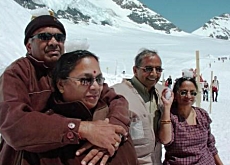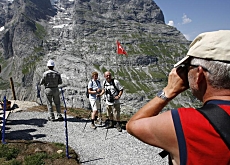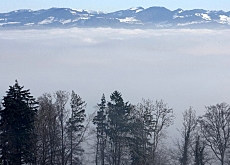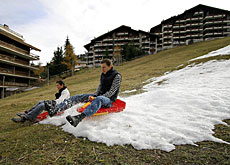Snow future for alpine tourism?

For the first time, a number of Swiss tourist regions have joined forces to develop a strategy to minimise the negative effects of climate change.
The nine destinations in the Bernese Alps commissioned a study by Bern University. The results are sobering, and the recommendations sweeping.
The study, “Climate change and tourism – an analysis of scenarios for the Bernese Oberland up to the year 2030” points out that the effects are manifold and complex.
They cannot, it says, be reduced to a simple formula equating rising temperatures with the disappearance of snow and therefore the death of skiing.
However, winter revenues will drop by around 30 per cent, and more than one-third of the region’s ski areas could cease to exist.
The good news for a region highly dependent on tourism is that warmer weather will lead to an increase in visitor numbers in summer, making up for a large chunk of the shortfall.
Based on both a best and worst case scenario, rising temperatures of between 0.4 and 2.6 degrees Celsius will cause an increase in precipitation in winter – falling as snow above 1,200m or 1,500m – and longer dry and sunny periods in summer.
It will also lead to the much-publicised retreat or complete disappearance of alpine glaciers, the less well-known thawing of permafrost and a possible rise in the number of foggy days.
“Until now, the presence or lack of snow for skiing has been the main issue but the effect on permafrost and glaciers is becoming more important,” Hansruedi Müller, head of Bern University’s Research Institute for Leisure and Tourism, told swissinfo.
“Permafrost decreases the stability of mountain slopes, and there are more extreme weather events which means increased precipitation, and there will be longer heatwaves. Tourism is affected in each case.”
Best case
Müller’s paper says even though only one of 38 ski areas in the Bernese Alps is threatened with extinction in the best-case scenario (a temperature rise of 0.4°C in winter), the maximum increase (+1.8°C) could put 13 out of business.
Among the hardest hit would be the upmarket but relatively low-lying resort of Gstaad which would be in danger of losing half of its lifts.
The report states that whichever scenario plays out, all mountain resorts will have to make major investments in order to adapt. As water becomes scarcer following dry summers, ski lift operators may have no choice but to import water to feed their growing arsenal of snow cannon.
The ski lift company in Grindelwald, for example, has to worry about ski lift masts sunk into a layer of unstable permafrost. The growth in risks will therefore increase insurance premiums and interest rates on bank loans.
Climate coin
And, Müller warns, marketing costs could soar since resorts will need to do more to attract a Swiss public, which could lose interest in skiing as winters in the low altitude urban areas where they live become milder.
There are, however, two sides to the climate coin. Tourists who now prefer to head to the seaside in July or August may prefer the coolness of higher altitudes to the stifling heat of the Mediterranean coast.
Gstaad and many other mountain resorts saw a large jump in hotel bookings during the record heatwave of 2003, and again during the hot period in July last year.
But alpine resorts continue to generate between two-thirds and 80 per cent of their turnover in the short winter season.
“For the mountain regions, there is no alternative to tourism but there are alternatives within tourism,” Müller says.
Diversify
The document advises resorts to diversify: increasing efforts to promote summer holidays in the Alps while acknowledging that one of the main summer attractions – its world of glaciers – is disappearing.
And as the ice sheets bid a hasty retreat, the mountain regions will become more prone to natural disasters such as flooding and landslides. The local authorities, according to the strategy paper, must become more pro-active in dealing with these hazards.
Crisis management and risk analysis will take on even greater significance than they have today in order to ensure the safety of tourists and to keep roads and rail lines open to facilitate travel.
And just as important, the resorts will need to improve public relations to influence media reports on natural disasters.
swissinfo, Dale Bechtel
Minimum scenario by 2030:
Winter: 0.4ºC rise
Summer: 0.6ºC rise
“Snowline” will rise in altitude by 50-60cm
A small increase in precipitation in winter, and minor decrease in summer
Slight increase in thawing of permafrost
Glacial retreat will continue at present rate
Maximum scenario by 2030:
Winter: 1.8ºC rise
Summer 2.6ºC rise
“Snowline” will rise in altitude by 250-270m
Precipitation to increase in winter by 11%
Precipitation to decrease in summer by 18%
Glacial retreat will speed up considerably
Thawing permafrost will cause increase in rockslides
Generally, more natural disasters expected

In compliance with the JTI standards
More: SWI swissinfo.ch certified by the Journalism Trust Initiative




You can find an overview of ongoing debates with our journalists here. Please join us!
If you want to start a conversation about a topic raised in this article or want to report factual errors, email us at english@swissinfo.ch.